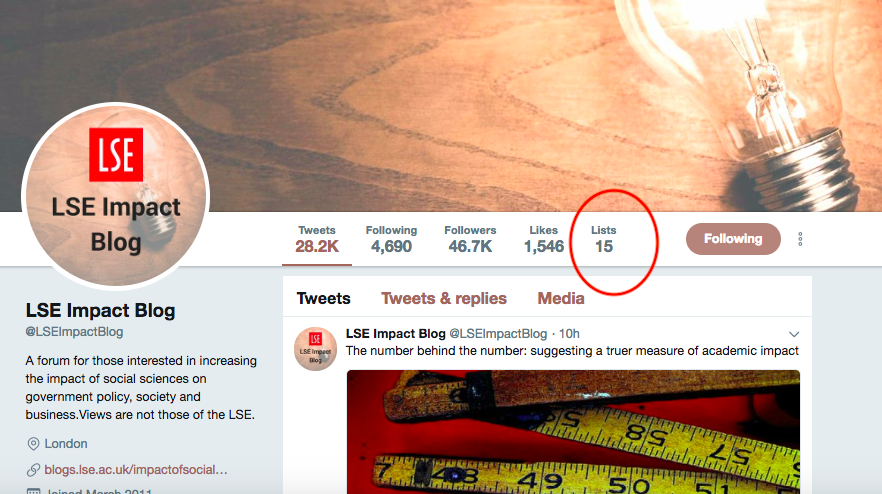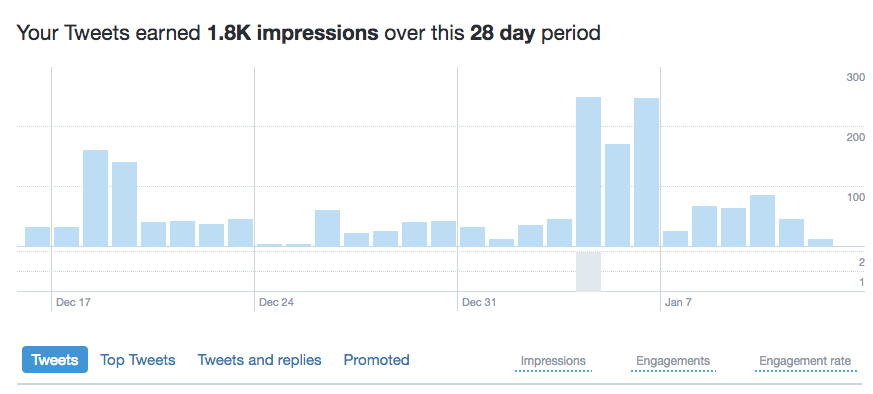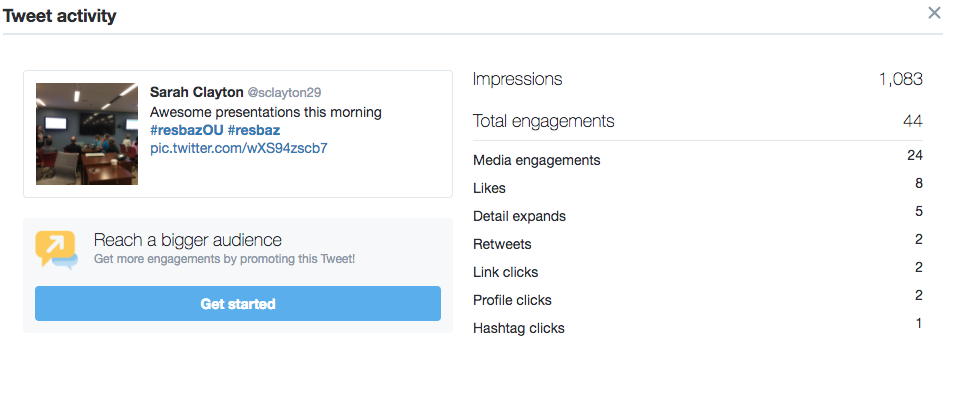← Go Back to the Impact Challenge Table of Contents
This week of the OU Impact Challenge will cover one of the biggest social media platforms on the planet: Twitter.
Twitter is a microblogging site with 335 million active users worldwide, and just over 35% of college faculty members were reportedly active on the site in 2010.
We know there has been backlash against Twitter over the past few years – a rise in toxic content, fake accounts, and Russian bots have led some to dismiss Twitter. And those who have never tried Twitter tend to dismiss it too.
Yet academics who use Twitter tend to be effusive in their praise: Twitter helps them stay on top of news in their field, find new publications, get speaking and publishing opportunities, communicate their research directly to the public, and – perhaps most importantly – find a sense of community. In fact, among academics who use social media in a professional context, 83% declared Twitter to be the most useful tool they use.
This week we’ll explore Twitter’s usefulness for you. We’ll get you onto the site, engaging others, finding the best sources of information in your field, and measuring the diffusion of your research among other researchers and the public. If you’re not already on Twitter, this may be the first activity in the OU Impact Challenge that takes you a step out of your comfort zone. But we encourage you to take that step and give it a try!
Step 1: Sign up
Creating a Twitter account is simple: go to Twitter.com to sign up for an account.
You will be asked to enter your name, email, and create a password. You can also enter your phone number for extra security.
You’ll next be asked to upload a photo. Like your username (see below), you’ll want to choose a photograph that represents you. Other Twitter users will use this to identify you, so while a photo of your cat or the mountains might resonate with you, they don’t particularly help others find you, and they don’t help you build your brand or a reputation. You will probably want to use this same photo across several different platforms that we’ll be covering in future chapters, and you probably want to use the same photo you used when you created your Google Scholar profile. A bonus: if you don’t have a professional photo, we’ll give you the opportunity to have one taken for free in a future challenge!
The next step will ask you about your interests. You can select some from the subjects provided, but we’re pretty certain these lists won’t cover your scholarly interests. Therefore, add a keyword into the search box, and a drop down menu appears. In this example, I’ve entered “evolution,” and I’ll select #Evolution (more about hashtags later).

Continue this a few more times with a few more keywords.
The next step is to choose your username. You will want to think about this a bit, because you will want to make it similar to your name on on other academic social media accounts, or you will want to your actual name (or something close), so your professional “brand” matches across platforms. Having an established brand will eventually help others find and identify you. And know that you can change your Twitter handle in your Profile Settings if you eventually decide your username doesn’t fit you or if your name changes.
After you’ve become more comfortable with Twitter, you may want to have another account (or two) that represent different or more focused interests, a collaboration, or a research lab. For now, let’s keep this simple!
After you have completed these steps, make sure to check your email to confirm your account.
Done with that? Now it’s time to do the important stuff.
Step 2: Personalize your account
Next, add a short bio. This is your chance to explain who you are in 160 characters or less. Say who you are, where you are, and what you do. Only share the information you are comfortable with, but it’s important to share something. Many Twitter users won’t follow you if you don’t have a biography or have a negative one, so make sure your biography is informative and approachable. LSE Impact Blog recommends stating your experience and research interests, university or organizational affiliation, and a link to your blog (if you don’t have a blog, we’ll help you change that in a future activity). We also recommend adding a few hashtags (more on those in a moment) that can connect you to other users with similar interests across the platform. In the example below, Peter Suber has added #OA and #openaccess as hashtags into his bio.

To add your bio, click on your username beside your avatar, and on your profile page, click the “Edit Profile” button on the right-hand side of your profile. There, you can add your bio and a link to your blog or website.
A few words about a public Twitter account vs. a private Twitter account. Public tweets are visible by anyone. Private (protected) tweets are only visible to your “followers,” and you will need to approve or deny each person who wishes to follow you. We are sensitive to wanting to maintain privacy, but one of the points of Twitter is to create a community and find people (and allow others to find you) with similar interests. Having a private account will limit this experience, so – at this point – we recommend having a public account for now. We talk more about the limitations of a private account below, and you can get additional information from Twitter’s Help Center and from the blog post Twitter 135: 10 Reasons to NOT Protect Your Tweets.
So...you’ve got your basic account set up? Now it’s time to start engaging with other researchers, your colleagues, and the public.
Step 3: Find people to follow
Twitter users share research articles, news, and tidbits about their lives on a daily basis. Your next step is to find users who share your interests and to “follow” them to start receiving their updates.
Twitter tries to make it as easy as possible for you to find other people to follow via the “Who to Follow” panel on the right side of your profile. Their recommendations are usually either spot on or completely off the mark.. The more people you follow, though, the better their system gets at finding you new suggestions. Click on the “View all” link in the “Who to follow” panel to get a long list of suggested users.
Another great way to find people to follow is to search Twitter for particular interests. From any page on Twitter, type a keyword into the search box at the upper right corner of the page. On the results page, click “People” from the menu bar under your search to narrow the results to Twitter users who match your interest.
You can see here that we’ve searched for the term “evolution” and narrowed the results to include Twitter users who match that term:

Read through the search results, keeping an eye out for familiar names and interesting bios. When you find a user you want updates from, click the “Follow” button in their bio. Now, when you’re on your homepage you’ll see their recent updates:

There are several other good ways to find people to follow:
- Take a look at who others are following (on their profile, click “Following”), scroll through the results, and follow people by clicking the “Follow” button. And here’s something else about Twitter: you do not need to know someone before following them. Follow those whose opinions you would like to read, not just your friends!
- You can find curated Twitter Lists on the profiles of those you follow, like these lists for STEM Academics, Media Academic Tweeters, OU Research, OU Colleges & Schools, OU Faculty & Staff, or OU Offices. To find these lists, go to a Twitter user’s profile page (e.g. https://twitter.com/LSEImpactBlog ) and select Lists:

Then click on a list that may interest you. In the example below, we chose “Soc Sci Academic Tweeters”

You can scroll through the tweets and find individuals to follow, or you can also subscribe to the entire list by selecting the “Subscribe” button in the upper left. WARNING: Selecting “Subscribe” in this case would mean you would follow 309 additional people. You may want to be careful subscribing to entire lists. Despite that, there are 1,241 subscribers to this particular list.
- Watch the updates on your Twitter homepage for unfamiliar names – chances are that someone has “retweeted” (shared someone else’s update) someone from whom you’d be interested in getting updates.
Try to follow at least twenty colleagues and organizations in your field to begin with, and take some time to read through each user’s “timeline” (updates on their profile page) to learn more about them and their interests. You’re going to start chatting with your colleagues in our next step. Other recommendations for who to follow include academic departments (at OU and elsewhere), universities, academic publishers, librarians, research centers, and local community groups. And, of course, please follow us at @OUOpenEd!
Step 4: Making connections on Twitter
Now we get into the meat of the challenge: making connections with others in your field.
One of the things that makes Twitter so great is that it is a no-pressure forum to spark conversations with your colleagues about a variety of topics, including but not limited to your shared area of study. Twitter also helps you find members of the public who are interested in your area of study.
Academics who participated in a 2014 study of academics’ use of social media reportedly appreciate Twitter because:
- “Love the ability to chat to colleagues on Twitter, better than seeing each other just once a year at conferences and actually I have “met” people on Twitter before meeting them IRL at conference.”
- “My focus is science outreach to general audiences. These formats [Facebook, Twitter, Storify] are easy to use and my audiences are there. It helps me disseminate information about science, science news and the process of science to broader audiences.”
- “Twitter allows me to make connections to folks that I would not otherwise have – journalists, policy professionals.”
You’re going to engage with others by tweeting at them – writing short messages that either respond to one of their updates, ask questions, or share information with them. Let’s talk now about what makes for good “tweeting.”
Basics of composing a tweet
Tweets are the 280 character messages that users compose to update others on a variety of things: their opinions on a study, recent news, a thought-provoking blog post, and so on. You can write anything in your updates (tweets), and attach photos and location information, too.
Some things you might want to share with others include:
- Recent papers in your field (both papers you’ve written and others’ articles). Note: if these articles are behind a paywall, some of your followers may not be able to access them.
- News and blog posts relevant to your discipline (science policy, funding announcements, articles our other favorite sources of information)
- Your opinion on developments in your field, others’ research, and so on
- A funny thing that happened in your lab, at a conference, or in the classroom
- Happenings from your personal life (are you enjoying your vacation? Did you meet a wallaby for the first time in your life? Are you proud of your most recent 5k-race time?)
No matter what you tweet about, there are some basic things you can do to make your tweets more interesting to others (and thus more likely to be shared via a retweet):
- Use hashtags (a word or phrase that follows the “#” sign, like #scicomm, #tenure, #digitalhumanities, #openaccess, or #phdlife).
- Attach a photo to your tweet (when composing a tweet, click the “Add photo” camera icon and upload a picture from your computer).
- Consider following the 5-3-2 rule: social media experts recommend that for every 10 updates you post, 5 should be content from others that are relevant to your followers, 3 should be professional content, and 2 should be personal updates.
When in doubt, just remember to keep it professional and you can’t really go wrong.
Tweeting at conferences
Now that you’re tweeting, let’s explore some of the benefits (and drawbacks) to tweeting at conferences.
Some academics swear by tweeting at conferences, because it provides an easy way to learn new things and meet new people by following and participating in conversations. As Bik & Goldstein explain,
“Tweeting from conferences (discussing cutting-edge research developments, linking to journal articles or lab websites, e.g., …) can introduce other scientists to valuable content, and consequently provide networking opportunities for users who actively post during meetings…Journalists and scientists following a conference tweet stream may be additionally introduced to new groups of researchers (particularly early-career scientists or those scientists who are new to Twitter) with relevant and related interests; conference tweeting can thus serve to enhance in-person networking opportunities by expanding these activities to online spheres.”
Further, Jonathan Lawson points out that it allows students and early career researchers, in particular, to participate in a “backchannel” that’s not dominated by the most established academics, like the conferences themselves sometimes are.
The next time you’re attending a conference, find out what the meeting’s hashtag is, and then search for and follow it to “listen in” on the conversation. (We searched for and followed tweets for #EuroSciPy).
A popular way to follow conference hashtags is through a third-party Twitter app called TweetChat. TweetChat filters out the non-conference tweets in your timeline, making conference-related tweets easier to follow.

And when you’re ready to participate, you can add your voice by writing tweets that include the conference hashtag (TweetChat adds the conference hashtag automatically). When you’re listening to a talk, summarize the main points for your followers, add your own commentary to the speaker’s, and share related papers and websites. However, be sure to tweet responsibly! It may be possible that presenters wish to keep their findings off the Internet until they have published them, or they may be working in a particularly controversial area. Also, try not misrepresent a presenter’s point through over-simplification. When possible provide a link for more context about the talk, and always try to tag the presenter in your tweet (a “tag” is simply mentioning someone’s Twitter handle with an @ in front of their name, such as @mbeisen, @OU14Pres, or @LincolnRiley).
You can also tweet using the conference hashtag to organize informal “tweetups” (gatherings/meetups), which can help build relationships and ward off boredom in unfamiliar cities (e.g. your tweet might be, “Invigorated after Stodden’s great keynote! Anyone up for grabbing a coffee before the reception to talk about it? #meeting2018”).
For more “how to’s” on conference tweeting, check out Southern Fried Science’s primer on tweeting at conferences.
Measuring your success
Twitter’s Analytics dashboard can help you measure the success of your outreach efforts.
Log on to Twitter Analytics. This will happen automatically, if you’re already logged onto Twitter. At the top of the page you will see an overview of your activity over the past 28 days.

To get a more in-depth look, click “Tweets” in the top menu bar. Here you’ll see all of your tweets and a summary of your impressions and engagements.

The number of impressions equals the number of times your tweets appeared on someone’s timelines. The number of engagements are the number of times your tweets have been retweeted, clicked through, or clicked on to learn more information about what you shared. They help you measure the amount of exposure you’re receiving and others’ interest in what you’re tweeting, respectively.
This view is good at summarizing your impressions and engagements over various time periods. The default view is for the past 28 days, but you can click the calendar button in the upper right corner to select a date range of your choosing – useful if you want to see what effect tweeting at a conference had upon the amount of exposure you’re getting, for example.
To see the drill-down engagement metrics for a specific tweet, click on the tweet. You’ll see something like this:

In addition to simple engagement and impression metrics, LSE Impact Blog also recommends recording the following:
At the end of each month, Twitter can be used as a painless metric to assess how your tweeting is working for you and your project or research. Showing the growth in your followers (and the number of people who read your research blog, which we’ll be covering in the future) can also be helpful for funding applications. You could make short notes on the following:
- The number of followers you have
- The names of those who could be useful for future collaboration
- Invitations to write blog posts or speak at events, which have come via Twitter
- Number of hits to your own blog posts (once we’ve set this up) via Twitter
Over time, you can build upon what you’ve learned from your Twitter metrics, tweeting more content that your followers will love, in a manner that will engage them the most.
Limitations
Twitter is, like many of the platforms we’ll be covering, a for-profit company. Though it’s technically free to use, you pay for your account by allowing Twitter show ads in your timeline and access and sell your personal data to other companies. And we’re all now aware of how spammers, bots and racists have tried to use Twitter to their own ends. Twitter is working on cleaning itself up, but it will take awhile.
You may have chosen to set your account to “private.” We understand the desire to carefully control (or curate) who sees your tweets, but there are some limitations to a private account that you may want to consider. For one, your tweets with hashtags will not be aggregated with other tweets that have the same hashtag. Secondly, the point of Twitter in this situation is to find your community and make connections. People may be less likely to follow you if they think they have to go through a vetting process first. We recommend, for the purposes of the OU Impact Challenge, to have a public profile.
Homework
For this week’s homework, you’re going to find other researchers to engage and begin tweeting in earnest.
We recommend following 20 people to begin with, adding a few each day using the techniques described above (keyword searches, Twitter lists, and following scholars who your colleagues are following). Aim to follow at least 100 people within the next month.
In the next few days, as you start to get a few followers, take some time to learn more about them. Using the Twitter Analytics “Audiences” dashboard, check out their general interests and what countries your followers are tweeting from. Using their Twitter profile page, find out who else they’re following – this can be a great source of new people to follow!
Finally, commit to tweeting at least 20 times over the next week. It will help populate your timeline, which will make others more likely to follow you. Share at least one of your own ideas, one of your articles, and engage someone else in conversation. It’s also okay to start out by RT (retweeting) others, but you need to put your own content in as well.
If tweeting that often seems like a lot – don’t worry! Soon we’ll show you how to automate your academic social media updates using a host of tools.